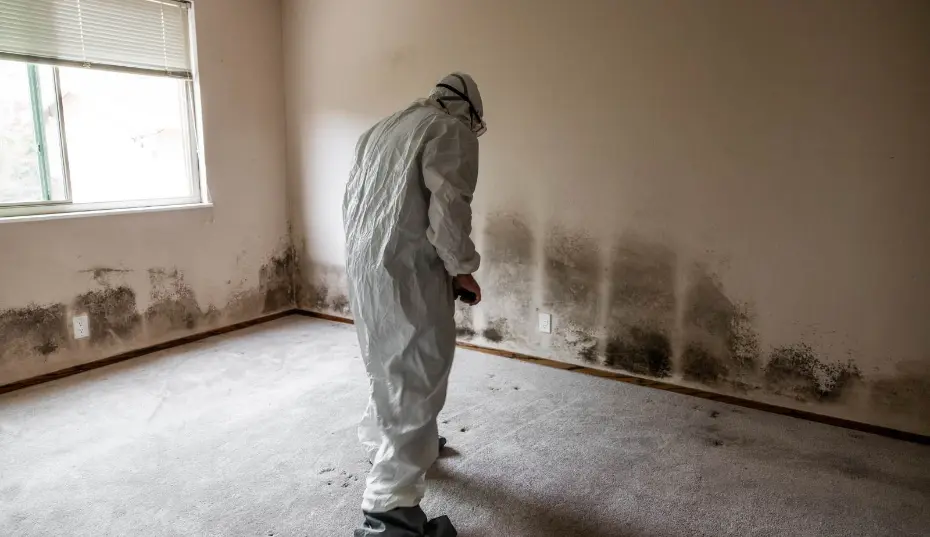Poor ventilation is a common issue in many Orange County homes, creating an environment conducive to mold growth. Areas such as attics, basements, and bathrooms are particularly susceptible due to trapped moisture and inadequate air circulation. Effective ventilation is essential for preventing mold, ensuring that humidity levels remain in check and promoting a healthy living space.
Residents may not realize that even minor dampness can lead to significant mold problems over time. Failure to address ventilation issues can result in costly damage and health risks for occupants. By understanding the connection between poor ventilation and mold, homeowners can take proactive measures to safeguard their properties.
Mastertech Environmental offers expertise in mold inspection and remediation, assisting homeowners in identifying hidden mold and implementing proper ventilation solutions. This proactive approach not only mitigates current mold problems but also helps prevent future occurrences, ensuring a safe and healthy home environment.
Why Poor Ventilation Causes Mold in Orange County, CA Homes
In Orange County, poor ventilation significantly contributes to mold growth. Elevated indoor humidity levels and moisture buildup create an environment where mold can thrive. Understanding the relationship between moisture, local climate, and specific sources of humidity is essential for homeowners to mitigate mold risks.
The Link Between Moisture and Mold Growth
Mold requires moisture to grow, often thriving in conditions with relative humidity levels above 60%. Poor ventilation traps humidity inside the home, creating a breeding ground for mold spores. Areas like bathrooms, kitchens, and basements are particularly vulnerable, as they often experience high moisture levels.
When moisture accumulates without proper airflow, it leads to condensation on surfaces. This condensation provides a perfect environment for mold growth, allowing it to spread quickly. Effective ventilation systems help regulate moisture levels and prevent condensation, thus inhibiting mold proliferation.
How Orange County’s Climate Contributes to Indoor Mold
Orange County's coastal climate presents unique challenges for homeowners. With high humidity levels, especially during the summer months, maintaining adequate indoor air quality becomes crucial. The proximity to the ocean increases moisture levels, making homes more susceptible to mold when ventilation is insufficient.
In periods of high humidity, especially after rain or damp conditions, indoor humidity can increase significantly. Homes that do not utilize exhaust fans or dehumidifiers can find humidity levels rising, creating ideal conditions for mold growth. Residents must ensure proper ventilation to combat these climate effects effectively.
Common Sources of Moisture Buildup from Poor Ventilation
Several common household activities contribute to moisture buildup. Cooking, showering, and even breathing generate humidity, which can accumulate in poorly ventilated spaces.
Key sources of moisture include:
- Bathrooms: Showers create steam, leading to high humidity levels.
- Kitchens: Cooking releases moisture and heat, which, without proper exhaust, can encourage mold.
- Laundry Rooms: Washing machines and drying clothes can significantly raise indoor humidity.
Addressing these common moisture sources through improved ventilation strategies is critical for maintaining a healthy indoor environment and preventing mold infestation.
Identifying Signs of Mold from Poor Ventilation
Identifying the signs of mold due to poor ventilation is essential for homeowners. Recognizing visible mold, detecting musty odors, and observing moisture accumulation can help prevent extensive damage.
Visible Mold on Walls, Ceilings, and Windows
Visible mold manifests as dark spots or patches on walls, ceilings, and even window frames. These areas often appear discolored, ranging from black to green or white. Mold thrives in damp environments, which are commonly found in poorly ventilated spaces.
Pay attention to areas prone to moisture, such as bathrooms and kitchens. Regular inspections of these surfaces can reveal hidden problems. Homeowners should also check behind furniture and in corners, where air circulation might be limited. Early detection can prevent larger mold infestations.
Detecting Musty Odors and Mold Spores
Musty odors are a clear indicator of mold presence. These smells often arise from decaying organic materials or mold spores. If a home smells damp or stale, it may suggest underlying issues related to ventilation and moisture.
Homeowners should act promptly if they notice these smells. While mold spores are often invisible to the naked eye, they can trigger health problems. Recognizing musty odors can lead to timely intervention and necessary measures for mold removal.
Signs of Condensation and Moisture Accumulation
Condensation forms on cool surfaces when warm air meets colder temperatures. It commonly appears on windows, mirrors, and metal fixtures, indicating high humidity levels. Prolonged condensation can lead to mold growth, especially in poorly ventilated spaces.
Moisture accumulation can also be seen in water stains on ceilings and walls. Homeowners should monitor for condensation regularly, especially in areas with limited airflow. Addressing moisture buildup promptly can significantly reduce the risk of mold growth and damage.
High-Risk Areas for Mold in Orange County Homes
Certain areas in Orange County homes are particularly susceptible to mold growth, primarily due to poor ventilation and high humidity levels. Understanding these spaces is crucial for homeowners looking to prevent mold infestations.
Attics and Crawl Spaces
Attics and crawl spaces often experience inadequate airflow, creating conditions that foster mold growth. In many Orange County homes, soffit vents and ridge vents are essential for attic ventilation. When these vents become blocked or insufficient, moisture can accumulate.
Without proper ventilation, heat and humidity can linger, leading to mold developing on rafters and insulation. Homeowners should regularly check these areas for signs of moisture or mold, especially after heavy rains. Adequate airflow through proper vent installation is key to reducing dampness in these secluded spaces.
Bathrooms and Kitchens
Bathrooms and kitchens are high-humidity areas prone to mold growth if not ventilated properly. Showers, sinks, and stoves generate moisture that can quickly build up without sufficient air circulation.
Installing exhaust fans helps to remove excess humidity, but they must be used effectively. Keeping bathroom doors closed while showering and running exhaust fans during and after bathing can minimize moisture. Regularly inspecting for leaks around sinks and faucets also plays a crucial role in preventing mold from establishing a foothold in these areas.
Windows, Sills, and Frames
Windows, sills, and frames can be problematic areas for mold development, particularly in homes near the coast. The ocean’s salt air can cause condensation to form on windows, and if not wiped away, this moisture creates an ideal environment for mold.
Homeowners should consider using mold-resistant paints and regularly checking for drafts or leaks that could introduce additional moisture. Cleaning and maintaining these areas frequently can help mitigate the risk of mold appearing on surfaces that are otherwise considered low-risk.
Basements and Garages
Basements and garages often harbor high humidity due to their underground or unconditioned nature. Ground moisture can seep into these spaces, raising the indoor humidity levels significantly.
Proper ventilation is vital to combat this issue. Homeowners may benefit from installing dehumidifiers in both basements and garages, particularly in the humid summer months. Regularly checking for leaks or water pooling, along with ensuring proper drainage outside the home, can make a significant impact in controlling moisture.
Health Risks of Mold from Poor Ventilation
Mold growth often stems from poor ventilation, creating an environment ripe for health issues. As mold spores proliferate, they can lead to various allergic reactions and respiratory complications.
Allergic Reactions and Respiratory Issues
Exposure to mold spores can trigger allergic reactions in sensitive individuals. Symptoms may include sneezing, coughing, runny nose, and itchy eyes. These reactions occur as the immune system responds to airborne allergens.
People with asthma or other respiratory conditions may experience aggravated symptoms, such as shortness of breath or chest tightness. Studies have linked mold exposure to an increase in asthma attacks, especially in children.
Key Points:
- Mold exposure can provoke allergic reactions and aggravate existing respiratory issues.
- Vulnerable populations include those with asthma, allergies, or compromised immune systems.
Long-Term Effects of Mold Exposure
Prolonged exposure to mold can lead to serious health complications. Chronic respiratory problems arise when mold spores linger in indoor air, leading to persistent coughing, wheezing, and even chronic sinusitis.
Individuals may also develop mold-related hypersensitivity pneumonitis, a condition resembling pneumonia. It is characterized by inflammation of the lungs, which can have lasting impacts on health.
Important Considerations:
- Long-term exposure can lead to chronic respiratory issues.
- Prompt action is essential to mitigate health risks linked to mold.
Understanding these health risks underscores the need for vigilance in maintaining proper ventilation to prevent mold growth.
Preventing Mold Growth Through Improved Ventilation
Effective ventilation is essential for preventing mold growth in homes. By implementing targeted strategies such as using exhaust fans, managing indoor humidity levels, and ensuring proper attic and basement ventilation, homeowners can significantly reduce the risk of mold development.
Using Exhaust Fans in Key Areas
Exhaust fans are crucial in areas prone to high moisture, such as kitchens and bathrooms. They help expel humid air, reducing steam and moisture accumulation.
Key Advantages of Exhaust Fans:
- Immediate Moisture Control: Running exhaust fans while cooking or showering dispels humidity, limiting conditions favorable for mold.
- Air Circulation: These fans promote air movement, helping to maintain a more stable environment.
Homeowners should ensure that exhaust fans vent directly outdoors. Regular maintenance, including cleaning filters, is also vital for optimal performance.
Managing Indoor Humidity Levels
Maintaining appropriate indoor humidity is fundamental for mold prevention. The ideal humidity level should stay between 30% and 50%.
Strategies to Manage Humidity Levels:
- Use Dehumidifiers: In areas with persistent moisture, dehumidifiers can effectively lower humidity levels.
- Monitor with Hygrometers: Regularly checking humidity with a hygrometer helps track and manage changes.
Ensuring proper ventilation when using appliances that generate moisture, such as dryers, is also important. Keeping indoor plants to a minimum can further enhance humidity control.
The Importance of Attic and Basement Ventilation
Proper ventilation in attics and basements is often overlooked but is critical for mold prevention. These areas can trap heat and moisture, creating an environment conducive to mold growth.
Ventilation Techniques Include:
- Intake and Exhaust Vents: Ensuring that both intake and exhaust vents are open allows for air circulation, preventing moisture build-up.
- Ridge and Soffit Vents: Installing these can help maintain a balanced airflow, reducing condensation.
Regular inspections of these areas should be conducted to check for signs of moisture accumulation or obstruction in vents. Addressing these issues quickly can prevent serious mold problems down the line.
Moisture Control Strategies for Orange County Homes
Effective moisture control is crucial for maintaining a healthy environment in Orange County homes. By implementing specific strategies, homeowners can significantly reduce moisture buildup, thereby minimizing the risk of mold growth.
Sealing Leaks and Enhancing Home Insulation
Identifying and sealing leaks is essential to prevent unwanted moisture entry. Areas around windows, doors, and walls are common culprits for air leaks. Using weather stripping and caulking can effectively seal these gaps.
Enhancing home insulation plays a crucial role in maintaining stable humidity levels. Proper insulation in attics, walls, and basements keeps indoor temperatures moderate and reduces condensation. This helps minimize moisture buildup that can lead to mold growth.
Regular checks for gaps and wear in insulation will help maintain effectiveness. Homeowners should also consider upgrading to energy-efficient materials that provide better moisture resistance.
Utilizing Dehumidifiers and Air Circulation
Dehumidifiers are vital in managing indoor humidity levels, especially in coastal regions prone to high moisture. By removing excess humidity, they help lower the chances of mold development. It is recommended to keep indoor humidity below 60% for optimal comfort and health.
In addition to dehumidifiers, improving air circulation can help disperse moisture. Ceiling fans and exhaust fans in kitchens and bathrooms can reduce humidity after cooking or showering. Properly positioned attic vents allow hot, humid air to escape, further protecting home integrity.
Homeowners should monitor humidity levels regularly to determine when to use dehumidifiers and to ensure adequate air flow throughout the house.
Regular Home Maintenance and Inspections
Routine maintenance is crucial for preventing moisture problems. Homeowners should inspect roofing, siding, and plumbing systems for signs of leaks or water damage. Promptly addressing any issues helps mitigate potential damage costs.
Cleaning gutters and downspouts regularly prevents water from pooling around the foundation, reducing the risk of moisture infiltration. Checking for condensation in places like crawl spaces and basements should also be a priority.
Scheduling professional inspections can help identify hidden moisture issues. Through consistent maintenance and timely repairs, residents can maintain a healthier home environment while preventing future mold growth.
Professional Mold Remediation and When to Seek Help
Mold growth in homes due to poor ventilation can lead to serious health issues and property damage. Professional mold remediation is crucial in addressing extensive mold infestations and restoring a safe environment.
The Mold Remediation Process
The mold remediation process typically involves several key steps. First, a thorough inspection of the affected areas is conducted. This helps identify the extent of the mold contamination and its source, often linked to poor ventilation.
Next, containment measures are taken to prevent mold spores from spreading. This may involve sealing off affected areas with plastic sheeting. After containment, the removal of the mold is executed. This process includes cleaning surfaces with specialized solutions to ensure all contaminants are eradicated.
In many cases, addressing underlying issues is vital. This can include improving ventilation to prevent future growth and may require repairs to water-damaged areas. Once remediation is complete, the area is restored, ensuring it is safe for occupants.
Choosing Mastertech Environmental in Orange County
When selecting a remediation service, Mastertech Environmental stands out for its expertise and customer-focused approach. With certified professionals, they offer comprehensive mold inspection and remediation services tailored to the unique challenges posed by domestic environments.
Clients can expect a thorough assessment that includes humidity levels and ventilation issues contributing to mold growth. The team prioritizes safety, employing state-of-the-art techniques to contain and eradicate mold effectively. Additionally, they educate homeowners on preventive measures to avoid future infestations, addressing sources of musty odors and moisture.
Choosing Mastertech also means benefiting from their commitment to customer satisfaction, ensuring a transparent and responsive service throughout the entire remediation process.
Frequently Asked Questions
This section addresses common inquiries regarding mold related to poor ventilation in homes. Understanding these aspects can help homeowners make informed decisions about prevention and remediation.
What are the common signs of mold caused by poor ventilation in homes?
Signs of mold from inadequate ventilation include visible mold growth, musty odors, and water stains on walls or ceilings. Homeowners may also notice increased humidity levels and condensation on windows, which can contribute to a conducive environment for mold.
How can inadequate ventilation contribute to mold growth in residential properties?
Inadequate ventilation leads to stagnant air and elevated humidity levels, creating ideal conditions for mold proliferation. Areas like bathrooms and kitchens are particularly susceptible, as moisture from daily activities can accumulate without proper airflow.
What are effective strategies for preventing mold in homes with ventilation issues?
To prevent mold, homeowners should enhance ventilation by using exhaust fans in moisture-prone areas. Regularly opening windows can improve airflow, and using dehumidifiers can help maintain optimal indoor humidity levels.
Can mold from ventilation problems affect indoor air quality, and how?
Yes, mold can significantly impact indoor air quality by releasing spores and volatile organic compounds. These contaminants can trigger allergic reactions and respiratory issues, making it essential to address mold problems promptly.
What professional remediation steps are suggested for addressing mold issues in homes?
Professional remediation typically involves assessing the extent of the mold problem, containing the area, and safely removing the mold. After removal, affected areas may be treated with antimicrobial solutions, followed by implementing measures to correct ventilation issues.
How often should homeowners in Orange County inspect their HVAC systems to prevent mold?
Homeowners should inspect their HVAC systems at least twice a year. Regular maintenance helps ensure proper airflow and reduces the risk of mold growth due to trapped moisture in ducts and filters.


